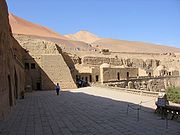
Bezeklik Thousand Buddha Caves
Encyclopedia

Shanshan
Shanshan is the Chinese name for a kingdom that existed roughly from 200 BCE-1000 CE at the north-eastern end of the Taklamakan Desert including the great, but now mostly dry, salt lake known as Lop Nur....
(Loulan) at the north-east of the Taklamakan Desert near the ancient ruins of Gaochang
Gaochang
Gaochang is the site of an ancient oasis city built on the northern rim of the inhospitable Taklamakan Desert in Xinjiang, China. A busy trading center, it was a stopping point for merchant traders traveling on the Silk Road...
in the Mutou Valley
Mutou Valley
Mutou Valley is located in the Flaming Mountains, near the ancient oasis city of Gaochang on the rim of the Taklamakan Desert in the Xinjiang Autonomous Region, China. Under a cliff in the Mutou Valley is located the Bezeklik Thousand Buddha Caves, a complex of Buddhist caves temples dating from...
, a gorge in the Flaming Mountains
Flaming Mountains
The Flaming Mountains or Gaochang Mountains are barren, eroded, red sandstone hills in Tian Shan Mountain range, Xinjiang, China. They lie near the northern rim of the Taklamakan Desert and east of the city of Turpan...
, China
China
Chinese civilization may refer to:* China for more general discussion of the country.* Chinese culture* Greater China, the transnational community of ethnic Chinese.* History of China* Sinosphere, the area historically affected by Chinese culture...
. They are high on the cliffs of the west Mutou Valley under the Flaming Mountains.
Bezeklik murals
There are 77 rock-cutRock cut architecture
Rock-cut architecture is the practice of creating buildings and other physical structures by carving natural rock. In India the term 'cave' is often applied, and in China 'cavern,' but one must differentiate natural caves from rock-cut architecture which is man-made and designed along the...
caves at the site. Most have rectangular spaces with rounded arch
Arch
An arch is a structure that spans a space and supports a load. Arches appeared as early as the 2nd millennium BC in Mesopotamian brick architecture and their systematic use started with the Ancient Romans who were the first to apply the technique to a wide range of structures.-Technical aspects:The...
ceiling
Ceiling
A ceiling is an overhead interior surface that covers the upper limit of a room. It is generally not a structural element, but a finished surface concealing the underside of the floor or roof structure above....
s often divided into four sections, each with a mural
Mural
A mural is any piece of artwork painted or applied directly on a wall, ceiling or other large permanent surface. A particularly distinguishing characteristic of mural painting is that the architectural elements of the given space are harmoniously incorporated into the picture.-History:Murals of...
of Buddha
Gautama Buddha
Siddhārtha Gautama was a spiritual teacher from the Indian subcontinent, on whose teachings Buddhism was founded. In most Buddhist traditions, he is regarded as the Supreme Buddha Siddhārtha Gautama (Sanskrit: सिद्धार्थ गौतम; Pali: Siddhattha Gotama) was a spiritual teacher from the Indian...
. The effect is of entire ceiling covers with hundreds of Buddha murals. Some ceilings are painted with a large Buddha surrounded by other figures, including Indians, Persians and Europeans. The quality of the murals vary with some being artistically naive while others are masterpieces of religious art.
Many of the murals were damaged by local Muslim population whose religion proscribed figurative images
Aniconism in Islam
Aniconism in Islam is a proscription in Islam against the creation of images of sentient living beings. The most absolute proscription is of images of Allah, followed by depictions of Muhammad, and then Islamic prophets and the relatives of the Prophet, but the depiction of all humans and animals...
of sentient beings, the eyes and mouths in particular were often gouged out. Later European explorers discovered intact murals and many were removed and dispersed around the world. Some of the most important murals were removed by German explorer Albert von Le Coq
Albert von Le Coq
Albert von Le Coq was a German archaeologist and explorer of Central Asia. He was heir to a sizable fortune derived from breweries and wineries scattered throughout Central and Eastern Europe, thus allowing him the luxury of travel and study at the - no longer existing - Ethnology Museum in Berlin...
and sent to Germany. However, many of them, especially the large pieces which were affixed onto museum walls and therefore cannot be removed for safekeeping, were destroyed during the Second World War when Berlin was bombed by the Allies
Allies of World War II
The Allies of World War II were the countries that opposed the Axis powers during the Second World War . Former Axis states contributing to the Allied victory are not considered Allied states...
. Other pieces may now be found in various museums around the world, such as the Hermitage Museum
Hermitage Museum
The State Hermitage is a museum of art and culture in Saint Petersburg, Russia. One of the largest and oldest museums of the world, it was founded in 1764 by Catherine the Great and has been opened to the public since 1852. Its collections, of which only a small part is on permanent display,...
in St. Petersburg, Tokyo National Museum
Tokyo National Museum
Established 1872, the , or TNM, is the oldest and largest museum in Japan. The museum collects, houses, and preserves a comprehensive collection of art works and archaeological objects of Asia, focusing on Japan. The museum holds over 110,000 objects, which includes 87 Japanese National Treasure...
in Japan, British Museum
British Museum
The British Museum is a museum of human history and culture in London. Its collections, which number more than seven million objects, are amongst the largest and most comprehensive in the world and originate from all continents, illustrating and documenting the story of human culture from its...
in London, as well museums in Korea and India.
A digital recreation of the Bezeklik murals removed by explorers was shown in Japan.

